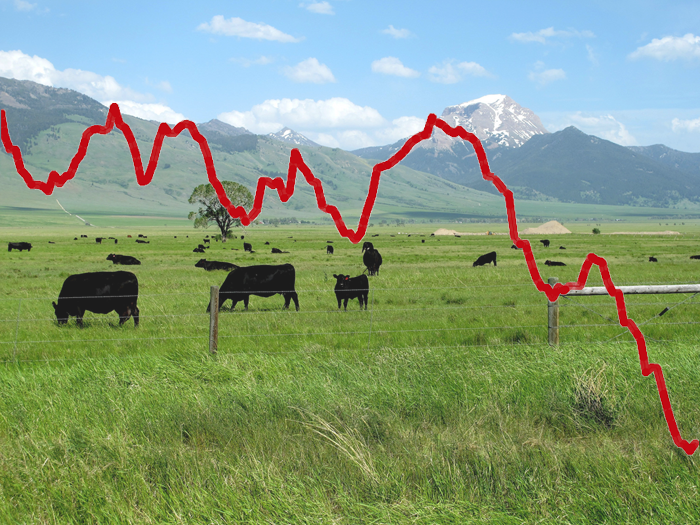Last Tuesday, one of the students in my Economics of Agricultural Markets class asked me a question that I hadn’t heard in several years, but is inevitably brought up when prices drop: Why is the U.S. meatpacking industry allowed to unfairly bring down prices for cattle producers and, as such, extract higher profit margins for themselves? The question was in part prompted by the fact that after a couple of years in which cattle producers received historically high prices (reaching approximately $2.60/lb for feeder cattle), the current feeder cattle futures price hovers around $1.21/lb, representing a 46.5% reduction in market prices.
Of course, the student is not the only one asking this type of question. The United Stockgrowers of America, for example, submitted a letter earlier this year to the U.S. Senate Judiciary Committee to investigate potential anti-competitive practices in the meatpacking industry. There have also been numerous news reports (here’s one as an example) of concern by the those in the feeder cattle industry who, too, believe that there is something fishy going on and that it’s the cattle producers who end up taking the brunt of the impacts.
Economics research has repeatedly shown, however, that there is little evidence that specifically anti-competitive behavior in the meatpacking industry substantially impacts feeder cattle market prices, especially in the short run. Instead, the issue is much more about market fundamentals.
Consider this question: How easily can feeder cattle producers adjust their herd sizes within a one-year period in response to changes in market prices?
Now consider this question: How easily can meat processors and packers adjust their production within a one-year period in response to changes in market prices?
Economists typically think of answering these questions in terms of “supply price elasticities,” which are measures that indicate the degree to which producers alter their decisions to sell more or fewer goods in response to a change in market prices. For example, if feeder cattle producers are highly elastic (versatile) to changes in prices, then they could easily and quickly adapt their herd sizes to adjust to changes in cattle markets.
However, that is not what economics research has repeatedly shown. One of the more recent studies has shown that in the short run, feeder cattle producers are highly unadaptable and unresponsive to changes in prices (for a 1% decrease in market prices, cattle producers only reduce their sales by 0.22%). That is, cattle producers cannot magically reduce their herd sizes and instantly adjust to new market conditions. They still need to manage, raise, and sell their animals.
This implies that feeder cattle producers have little leverage and are more likely to take on a larger incidence of market price reductions (i.e., they have less opportunities to not sell their cattle when market prices are low and, as a result, have to accept what the market gives them). For this reason, another study found that for every 1% decrease in the price of beef at the retail level, feeder cattle prices decrease, on average, 1.30%.
Processing facilities, on the other hand, have more flexibility in managing slaughter quantities and inventories, and are thus able to use this additional leverage to pass on the costs to feeder cattle producers. Markets observe similar conditions (albeit in reverse) when the demand for beef products increases. As was the case 2-3 years ago—when the 2014 Porcine epidemic diarrhea virus (PEDv) and the 2015 avian influenza may have led some consumers to temporarily switch to higher beef consumption—processors and packers responded by increasing their production and, in turn, increasing market demand for feeder cattle. Because this demand occurred during a period when herd sizes were already relatively small after significant cattle culling in response to the 2012-14 droughts and the biological constraints of cattle production limit the speed with which new cattle can be produced to meet the demand, it was the feeder cattle market that most benefited in the form of historically high prices, while the fed cattle and packers were left with lower profit margins.
In both cases—expansion or contraction of production—processing and packing facilities are not necessarily doing anything that is anti-competitive or illegal, but simply acting efficiently in the marketing landscape they face. Market fundamentals and the nature of cattle production are, thus, likely to blame.
The silver-lining for the current price decreases is that in the longer run, research has found that feeder cattle producers become much more responsive to market conditions. As such, producers are able to adjust their production and sales capacity to again gain leverage and become more competitive in the cattle market.
UPDATE: Find a follow-up post about how Brazilian imports and the country-of-origin labeling law may have (or haven’t) impacted feeder cattle prices.

